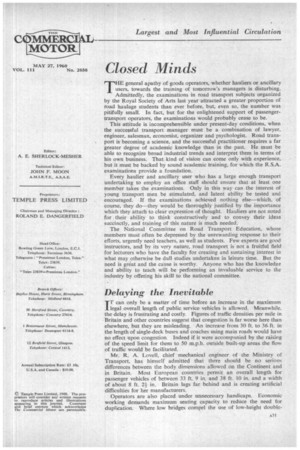Closed Minds
Page 33

Page 34

If you've noticed an error in this article please click here to report it so we can fix it.
THE general apathy of goods operators, whether hauliers or ancillary users, towards the training of tomorrow's managers is disturbing. Admittedly, the examinations in road transport subjects organized by the Royal Society of Arts last year attracted a greater proportion of road haulage students than ever before, but, even so, the number was pitifully small. In fact, but for the enlightened support of passengertransport operators, the examinations would probably cease to be.
This attitude is incomprehensible under present-day conditions, when the successful transport manager must be a combination of lawyer, engineer, salesman, economist, organizer and psychologist. Road transport is becoming a science, and the successful practitioner requires a far greater degree of academic knowledge than in the past. He must be able to recognize broad industrial trends and interpret them in terms of his own business. That kind of vision can come only with experience, but it must be backed by sound academic training, for which the R.S.A. examinations provide a foundation.
Every haulier and ancillary user who has a large enough transport undertaking to employ an office staff should ensure that at least one member takes the examinations. Only in this way can the interest of young transport men be stimulated, and latent ability be tested and encouraged. If the examinations achieved nothing else—which, of course, they do—they would be thoroughly justified by the importance which they attach to clear expression of thought. Hauliers are not noted for their ability to think constructively and to convey their ideas succinctly, and training of this nature is much needed.
The National Committee on Road Transport Education, whose members must often be depressed by the unrewarding response to their efforts, urgently need teachers, as well as students. Few experts are good instructors, and by its very nature, road transport is not a fruitful field for lecturers who have the faculty for creating and sustaining interest in what may otherwise be dull studies undertaken in leisure time. But the need is gre-at and the cause is worthy. Anyone who has the knowledge and ability to teach will be performing an invaluable service to the industry by offering his skill to the national committee.
Delaying the Inevitable
TT can only be a matter of time before an increase in the maximum 'legal overall length of public service vehicles is allowed. Meanwhile, the delay is frustrating and costly. Figures of traffic densities per mile in Britain and other countries suggest that congestion is far worse here than elsewhere, but they are misleading. An increase from 30 ft. to 36.ft. in the length of single-deck buses and coaches using main roads would have no effect upon congestion. Indeed if it were accompanied by the raising of the speed limit for them to 50 m.p.h. outside built-up areas the flow of traffic would be facilitated.
Mr. R. A. Lovell, chief mechanical engineer of the Ministry of Transport, has himself admitted that there should be no serious differences between the body dimensions allowed on the Continent and in Britain. Most European countries permit an overall length for passenger vehicles of between 33 ft. 9 in. and 38 ft. 10 in. and a width of about 8 ft. 21 in. Britain lags far behind and is creating artificial difficulties for her manufacturers.
Operators are also placed under unnecessary handicaps. Economic working demands maximum seating capacity to reduce the need for duplication. Where low bridges compel the use of low-height double deckers with small seating capacities, 36 ft. singledeckers could provide similar accommodation at lower cost. At a time of ever-rising costs this is an important matter.
The group certification of new public service vehicles is another urgent need. Amending legislation would be required to enable full advantage to be taken of it, for under the present law of type approval it is still necessary to have every vehicle separately examined. Group certification would be a great convenience to operators and would in no way lower the high standard of safety demanded of public service vehicles.
But in amending the law to allow the use of bigger buses the interests of the, rural operator must not be forgotten. There are still many roads that will not accommodate vehicles wider than 7 ft. 6 in. Country operators complain that chassis manufacturers and bodybuilders are so obsessed by the magic width of 8 ft. that fhey have little time for the small man in the rural district who requires a narrower bus. He is performing a vital public service and his needs must not be overlooked.
















































































































